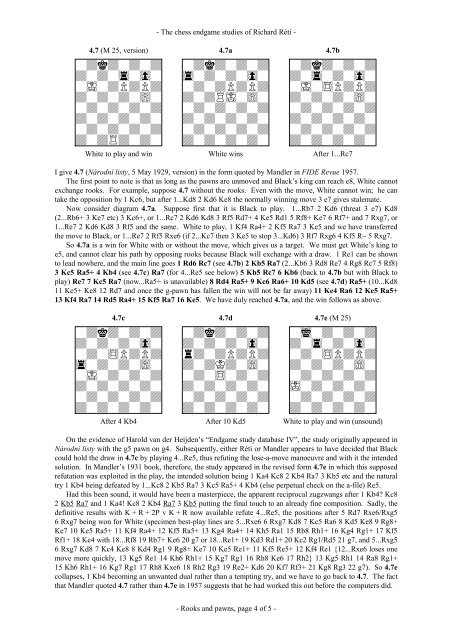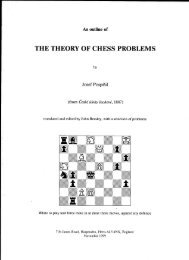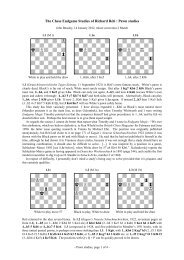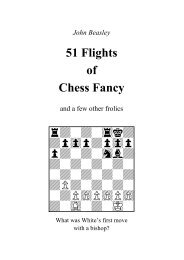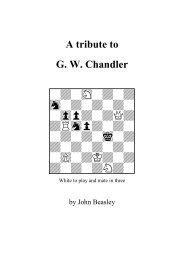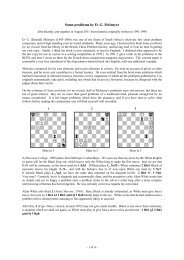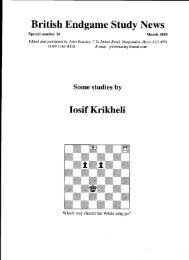The Chess Endgame Studies of Richard Réti - JSB
The Chess Endgame Studies of Richard Réti - JSB
The Chess Endgame Studies of Richard Réti - JSB
You also want an ePaper? Increase the reach of your titles
YUMPU automatically turns print PDFs into web optimized ePapers that Google loves.
- <strong>The</strong> chess endgame studies <strong>of</strong> <strong>Richard</strong> <strong>Réti</strong> -<br />
4.7 (M 25, version) 4.7a 4.7b<br />
wdkdwdwd wdkdwdwd wdkdwdwd<br />
dwdw4w0w 4wdwdw0w dw4wdw0w<br />
wIwdPdPd wdwdPdPd wIw$PdPd<br />
dwdwdw)w dwdRIw)w dwdwdw)w<br />
wdwdwdwd wdwdwdwd wdwdwdwd<br />
dwdwdwdw dwdwdwdw dwdwdwdw<br />
wdwdwdwd wdwdwdwd wdwdwdwd<br />
dwdRdwdw dwdwdwdw dwdwdwdw<br />
White to play and win White wins After 1...Rc7<br />
I give 4.7 (Národní listy, 5 May 1929, version) in the form quoted by Mandler in FIDE Revue 1957.<br />
<strong>The</strong> first point to note is that as long as the pawns are unmoved and Black’s king can reach e8, White cannot<br />
exchange rooks. For example, suppose 4.7 without the rooks. Even with the move, White cannot win; he can<br />
take the opposition by 1 Kc6, but after 1...Kd8 2 Kd6 Ke8 the normally winning move 3 e7 gives stalemate.<br />
Now consider diagram 4.7a. Suppose first that it is Black to play. 1...Rb7 2 Kd6 (threat 3 e7) Kd8<br />
(2...Rb6+ 3 Ke7 etc) 3 Kc6+, or 1...Rc7 2 Kd6 Kd8 3 Rf5 Rd7+ 4 Ke5 Rd1 5 Rf8+ Ke7 6 Rf7+ and 7 Rxg7, or<br />
1...Re7 2 Kd6 Kd8 3 Rf5 and the same. White to play, 1 Kf4 Ra4+ 2 Kf5 Ra7 3 Ke5 and we have transferred<br />
the move to Black, or 1...Re7 2 Rf5 Rxe6 (if 2...Kc7 then 3 Ke5 to stop 3...Kd6) 3 Rf7 Rxg6 4 Kf5 R~ 5 Rxg7.<br />
So 4.7a is a win for White with or without the move, which gives us a target. We must get White’s king to<br />
e5, and cannot clear his path by opposing rooks because Black will exchange with a draw. 1 Re1 can be shown<br />
to lead nowhere, and the main line goes 1 Rd6 Rc7 (see 4.7b) 2 Kb5 Ra7 (2...Kb6 3 Rd8 Re7 4 Rg8 Rc7 5 Rf8)<br />
3 Kc5 Ra5+ 4 Kb4 (see 4.7c) Ra7 (for 4...Re5 see below) 5 Kb5 Rc7 6 Kb6 (back to 4.7b but with Black to<br />
play) Re7 7 Kc5 Ra7 (now...Ra5+ is unavailable) 8 Rd4 Ra5+ 9 Kc6 Ra6+ 10 Kd5 (see 4.7d) Ra5+ (10...Kd8<br />
11 Ke5+ Ke8 12 Rd7 and once the g-pawn has fallen the win will not be far away) 11 Ke4 Ra6 12 Ke5 Ra5+<br />
13 Kf4 Ra7 14 Rd5 Ra4+ 15 Kf5 Ra7 16 Ke5. We have duly reached 4.7a, and the win follows as above.<br />
4.7c 4.7d 4.7e (M 25)<br />
wdkdwdwd wdkdwdwd wiwdwdwd<br />
dwdwdw0w dwdwdw0w dw4wdw0w<br />
wdw$PdPd rdwdPdPd wdw$PdPd<br />
4wdwdw)w dwdKdw)w dwdwdw)w<br />
wIwdwdwd wdw$wdwd wdwdwdwd<br />
dwdwdwdw dwdwdwdw Iwdwdwdw<br />
wdwdwdwd wdwdwdwd wdwdwdwd<br />
dwdwdwdw dwdwdwdw dwdwdwdw<br />
After 4 Kb4 After 10 Kd5 White to play and win (unsound)<br />
On the evidence <strong>of</strong> Harold van der Heijden’s “<strong>Endgame</strong> study database IV”, the study originally appeared in<br />
Národní listy with the g5 pawn on g4. Subsequently, either <strong>Réti</strong> or Mandler appears to have decided that Black<br />
could hold the draw in 4.7c by playing 4...Re5, thus refuting the lose-a-move manoeuvre and with it the intended<br />
solution. In Mandler’s 1931 book, therefore, the study appeared in the revised form 4.7e in which this supposed<br />
refutation was exploited in the play, the intended solution being 1 Ka4 Kc8 2 Kb4 Ra7 3 Kb5 etc and the natural<br />
try 1 Kb4 being defeated by 1...Kc8 2 Kb5 Ra7 3 Kc5 Ra5+ 4 Kb4 (else perpetual check on the a-file) Re5.<br />
Had this been sound, it would have been a masterpiece, the apparent reciprocal zugzwangs after 1 Kb4? Kc8<br />
2 Kb5 Ra7 and 1 Ka4! Kc8 2 Kb4 Ra7 3 Kb5 putting the final touch to an already fine composition. Sadly, the<br />
definitive results with K + R + 2P v K + R now available refute 4...Re5, the positions after 5 Rd7 Rxe6/Rxg5<br />
6 Rxg7 being won for White (specimen best-play lines are 5...Rxe6 6 Rxg7 Kd8 7 Kc5 Ra6 8 Kd5 Ke8 9 Rg8+<br />
Ke7 10 Ke5 Ra5+ 11 Kf4 Ra4+ 12 Kf5 Ra5+ 13 Kg4 Ra4+ 14 Kh5 Ra1 15 Rb8 Rh1+ 16 Kg4 Rg1+ 17 Kf5<br />
Rf1+ 18 Ke4 with 18...Rf8 19 Rb7+ Ke6 20 g7 or 18...Re1+ 19 Kd3 Rd1+ 20 Kc2 Rg1/Rd5 21 g7, and 5...Rxg5<br />
6 Rxg7 Kd8 7 Kc4 Ke8 8 Kd4 Rg1 9 Rg8+ Ke7 10 Ke5 Re1+ 11 Kf5 Re5+ 12 Kf4 Re1 {12...Rxe6 loses one<br />
move more quickly, 13 Kg5 Re1 14 Kh6 Rh1+ 15 Kg7 Rg1 16 Rh8 Ke6 17 Rh2} 13 Kg5 Rh1 14 Ra8 Rg1+<br />
15 Kh6 Rh1+ 16 Kg7 Rg1 17 Rh8 Kxe6 18 Rh2 Rg3 19 Re2+ Kd6 20 Kf7 Rf3+ 21 Kg8 Rg3 22 g7). So 4.7e<br />
collapses, 1 Kb4 becoming an unwanted dual rather than a tempting try, and we have to go back to 4.7. <strong>The</strong> fact<br />
that Mandler quoted 4.7 rather than 4.7e in 1957 suggests that he had worked this out before the computers did.<br />
- Rooks and pawns, page 4 <strong>of</strong> 5 -


